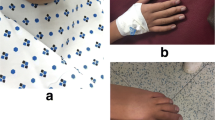Abstract
Muscular pulmonary atresia with intact ventricular septum (PA/IVS) in neonates is traditionally managed by surgery. We describe hybrid approach to decompress the right ventricle (RV) and establish RV to pulmonary artery connection in a neonate avoiding cardiopulmonary bypass. A 21-gauge access needle was used to perforate the atretic pulmonary valve via periventricular approach followed by stent placement. This case is an example of how patients with congenital heart disease can be palliated in creative ways through thoughtful collaboration between surgical and interventional cardiology teams.



Similar content being viewed by others
References
El Shedoudy S, El-Doklah E (2018) Transcatheter perforation of atretic pulmonary valve by the stiff end of a coronary wire in neonates with pulmonary atresia with intact ventricular septum: A solution in developing countries. J Saudi Heart Assoc 30:222–232. https://doi.org/10.1016/j.jsha.2018.01.002
Wright LK, Knight JH, Thomas AS, Oster ME, St Louis JD, Kochilas LK (2019) Long-term outcomes after intervention for pulmonary atresia with intact ventricular septum. Heart 105:1007–1013. https://doi.org/10.1136/heartjnl-2018-314124
Alcíbar-Villa J, Rubio A, Peña N, Galdeano JM, Luis M, Arriola J, Inguanzo R, Pérez-Asenjo J, Aramendi JI, Barrenechea JI (2007) Pulmonary atresia with intact ventricular septum: perforation and pulmonary valvuloplasty using a modified mechanical technique: medium-term follow-up. Rev Esp Cardiol 60:833–840
Zampi JD, Hirsch-Romano JC, Goldstein BH, Shaya JA, Armstrong AK (2014) Hybrid approach for pulmonary atresia with intact ventricular septum: early single center results and comparison to the standard surgical approach. Catheter Cardiovasc Interv 83:753–761. https://doi.org/10.1002/ccd.25181
Cheatham JP (1997) To perforate or not to perforate-that’s the question… or is it? Just ask Richard! Cathet Cardiovasc Diagn 42:403–404. https://doi.org/10.1002/(SICI)1097-0304(199712)42:4<403::AID-CCD12>3.0.CO;2-K
Ovaert C, Qureshi SA, Rosenthal E, Baker EJ, Tynan M (1998) Growth of the right ventricle after successful transcatheter pulmonary valvotomy in neonates and infants with pulmonary atresia and intact ventricular septum. J Thorac Cardiovasc Surg 115:1055–1062. https://doi.org/10.1016/S0022-5223(98)70405-2
Gibbs JL, Blackburn ME, Uzun O, Dickinson DF, Parsons JM, Chatrath RR (1997) Laser valvotomy with balloon valvoplasty for pulmonary atresia with intact ventricular septum: five years' experience. Heart 77:225–228. https://doi.org/10.1136/hrt.77.3.225
Bakhru S, Marathe S, Saxena M, Verma S, Saileela R, Dash TK, Koneti NR (2017) Transcatheter pulmonary valve perforation using chronic total occlusion wire in pulmonary atresia with intact ventricular septum. Ann Pediatr Cardiol 10:5–10. https://doi.org/10.4103/0974-2069.197065
Alwi M, Budi RR, Mood MC, Leong MC, Samion H (2013) Pulmonary atresia with intact septum: the use of conquest pro coronary guidewire for perforation of atretic valve and subsequent interventions. Cardiol Young 23:197–202. https://doi.org/10.1017/S1047951112000595
Petit CJ, Glatz AC, Qureshi AM, Sachdeva R, Maskatia SA, Justino H, Goldberg DJ, Mozumdar N, Whiteside W, Rogers LS, Nicholson GT, McCracken C, Kelleman M, Goldstein BH (2017) Outcomes after decompression of the right ventricle in infants with pulmonary atresia with intact ventricular septum are associated with degree of tricuspid regurgitation: results from the Congenital Catheterization Research Collaborative. Circ Cardiovasc Interv 10:e004428. https://doi.org/10.1161/CIRCINTERVENTIONS.116.004428
Acknowledgements
Special thanks to Yashesh R. Savani MD, Jessica M. Guiles PNP-AC, Paul M. Nelson BS, RCIS, and Dalton J. Jacobs BS for assisting in the case, and Bennett P. Samuel MHA, BSN, RN for editorial support.
Author information
Authors and Affiliations
Corresponding author
Ethics declarations
Conflicts of interest
The authors declare that there is no conflict of interest.
Research Involving Human Participants
All procedures performed in studies involving human participants were in accordance with the ethical standards of the institutional and/or national research committee and with the 1964 Helsinki Declaration and its later amendments or comparable ethical standards.
Informed Consent
As our case report does not meet the definition of research, it is not subject to institutional review board (IRB) oversight as per the Spectrum Health IRB. As such informed consent was not obtained from the individual participant included in the case report.
Additional information
Publisher's Note
Springer Nature remains neutral with regard to jurisdictional claims in published maps and institutional affiliations.
Rights and permissions
About this article
Cite this article
Mohammad Nijres, B., Al-Khatib, Y., Baliulis, G. et al. Hybrid Approach to Right Ventricle Decompression in Muscular Pulmonary Atresia with Intact Ventricular Septum. Pediatr Cardiol 41, 1238–1241 (2020). https://doi.org/10.1007/s00246-020-02364-5
Received:
Accepted:
Published:
Issue Date:
DOI: https://doi.org/10.1007/s00246-020-02364-5




